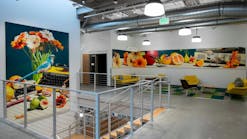Patients at Schuyler Ridge often find it difficult to get out of bed at night because the lighting controls are out of reach. Additionally, nurses check patients several times during the night by repeatedly turning on the overhead lighting, which is uncomfortably bright and disturbs patients' sleep.
The LRC team determined that an automated, non-disturbing lighting scheme could be designed to help patients get in and out of bed at night, as well as give nurses enough light for their rounds. Hallways could be distinguished through the use of colored lighting, which theoretically would serve as a navigational guide for residents and visitors.
Custom LED fixtures were installed in four patient bedrooms and bathrooms and in one hallway. LRC researchers mounted amber-colored LEDs under each bed frame, around the bathroom door, and under the bathroom mirror and handrail.Jean Paul Freyssinier, LRC lighting design specialist, says the bed frame lighting was selected specifically to illuminate the floor, allowing patients and nurses a clear passage during the night. "By putting the light on the floor where it is needed, we can use fewer lumens and less power than with overhead lighting," he says.
The doorframe lighting system created enough indirect light to adequately illuminate the room without causing glare. An occupancy sensor slowly turned the lights on when a patient got out of bed or a nurse walked into the room. Hallway lights were mounted to the backside of a handrail and remained switched on.
Surveys conducted with patients and staff reported no problems with sleep disturbance or discomfort with the LED lighting. Nurses confirmed that there was enough light in the bedrooms to perform their rounds and said the automated lighting was convenient and useful; however, nurses commented that more light in bathrooms was needed.
"The responses we received show that there is an opportunity and need for innovative lighting designed specifically for seniors and staff in long-term care facilities," said LRC light and health researcher Mariana Figueiro.
The study was sponsored by the ASSIST group and OSRAM Opto Semiconductors. After completing the study, the LRC made arrangements with OSRAM Opto Semiconductors to donate the automated LED systems used in the experiments to Schuyler Ridge.
Figueiro notes that the next steps will be education - both for senior-care workers and manufacturers - and working with manufacturers to develop LED lighting products that can be purchased off-the-shelf.
"Right now, elderly-care facilities cannot easily purchase and install LED systems that will allow them to replicate the study's designs," says Figueiro. Cost is also an issue, she says; however, with greater availability and demand for such systems, prices are likely to come to down in the future.







